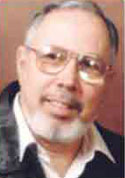IN MEMORIAM – By Des Kelly
The end of July, this year (2018), should bring back memories of one of Ceylon’s most talented artists of the 20th Century. It was on the 31st July, 1993, that Sri Lankan artist Kalasuri George Keyt passed away after a short illness, at a private nursing home in Colombo. He was 92.
V.M.(I believe that it could have been none other than my good friend,Victor Melder, has written this story about G.K.), and I can inform all our eLanka readers that, when it comes to “news from Ceylon”, what Victor does not know about Lanka, generally, is certainly not worth knowing. Anyway, let us leave V.M.(the human encyclopaedia), for the moment, to carry on with the human-interest story of this very famous “Son of Lanka”, on what is the 25th anniversary of his passing.
George Keyt was born in Kandy on the 17th of April, 1901 to a wealthy family of Dutch descent and spent most of his life in the beautiful hill Capital. He began his school life in Kalatura, at St.Helen’s School, there, and later attended Trinity College Kandy. In Sri Lanka, only a few people were “legends in their own lifetime, but George Keyt, with his creative flair on the canvas and his prodigious output earned him the reputation of being a “National Institution”.
He began painting at the age of 23, depicting the people of Kandy, their culture, and the tea fields. Among his works of repute during this neophyte phase, often referred to, as the “Kandyan period”, is the painting in oils, called the “Ambalama”. In 1939, overcome by an emotional crisis, he stopped painting, turned to writing, and published three volumes of poetry. Here was a man who could do nothing in halves. There was no way that he could have half a crisis, he had to have a whole one. There was no way that he would then write just one or two volumes of poetry, he wrote three of them. Then, in that same year, George toured India, visiting temples and shrines he had previously read about. He then immersed himself in the literature and art of India, which, in turn, provided many impulses for future paintings, after he returned home. He then went back to painting, concentrating on the magnificent0 murals of the “Gothami Vihara” in Borella (like his Artist ancestors before him, fulfilling a creative act of devotion). These murals gained him International recognition.
In the early 1940’s Keyt began the “Nayika” group of paintings which, for many, represent his peak of perfection.
The delightfully delicate North Indian miniature paintings had been inspired by the Nayika tradition (usually translated as “heroine”, although the word “beloved” was favoured by Keyt), who produced these exquisite paintings of women are accomplished in natural flesh-tones, and others in tawny browns and soft warm ochres & yellows. The foliage and flowers against which the figures are placed, have been stylised and simplified almost to abstraction. The lines are sensuous and glide freely and easily. They represent ALL women, and yet, no Woman in particular. Very clever, George.
What people saw in his works, soon to become a notable stamp of his creative quality, was his ability to “marry” the Western idiom of cubist art, with his Eastern themes. This is best seen in those works that incorporate the “canvas language” of another Artist Icon, Pablo Piccaso, the Spanish Master of Art, with subjects located in the Hindu tradition and pastoral Ceylon. Besides exhibiting with Piccaso and Barque, he has had his “works” displayed in art-galleries in most leading Capitals of the World. Such an International reputation did not stop him from painting, however. Instead, he kept returning regularly, to his palette and canvas for close to 75 years.
The frail, silver-haired Artist continued to paint until his death. In later years, he worked on the theme of love, and painted mostly nudes. He was known as Sri Lanka’s greatest modern Artist, who had over 12.000 paintings, writings, and other creative works, to his credit. Keyt also published several books of his paintings and regularly held exhibitions both in Colombo and Kandy.
George Keyt’s mortal remains “laid in state” at the National Art Gallery, from where it was taken to St.Michael’s & All Angels’ Church at Polwatte, Kollupitiya, where a Christian service was held. Following this service, the remains were cremated at Kanatte! After a special Buddhist ceremony, conducted by the bhikkus of the Gothami Vihara, Borella.
Kalusuri George Keyt left behind, his wife Kusum, and three children, Diana, Flavia & Sachin. Yet another Lankan Artist of renown, never to be forgotten has now been in his “Studio in the sky” for quarter of a century, hence, this is “IN MEMORIAN” to him. Regrettably, details of his immediate family are unknown, at the moment.
Desmond (Kelly from Colombo).









No Comments